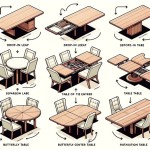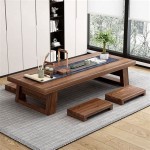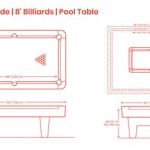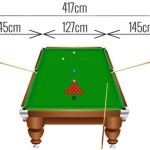Rustic Round Dining Table For 8: A Comprehensive Guide
A rustic round dining table designed to accommodate eight individuals serves as a central gathering point for meals, conversations, and shared experiences. These tables, characterized by their organic materials, warm tones, and often deliberately distressed finishes, bring a sense of natural elegance and inviting comfort to any dining space. Selecting the right rustic round dining table for eight requires careful consideration of several factors, including material, size, style, and suitability for the intended environment.
The appeal of a rustic round dining table lies in its ability to foster intimacy and encourage interaction. The circular shape allows for equal sightlines and eliminates the hierarchical aspect associated with rectangular tables, where those seated at the head often hold a perceived position of greater authority. This makes round tables ideal for casual gatherings, family dinners, and environments where inclusivity is valued. The rustic aesthetic adds another layer of appeal, imbuing the space with a sense of history, authenticity, and connection to the natural world.
Understanding Material Options
The choice of material is paramount in determining the durability, aesthetic, and overall character of a rustic round dining table. Several materials are commonly used, each offering unique properties and visual characteristics.
Solid wood, particularly hardwoods like oak, maple, and walnut, is a popular choice for rustic dining tables. These woods offer exceptional strength, longevity, and the inherent beauty of natural grain patterns. Oak, known for its durability and distinctive grain, is a practical choice for high-traffic areas. Maple, with its smooth texture and lighter color, provides a more refined rustic aesthetic. Walnut, prized for its rich, dark tones and elegant grain, adds a touch of sophistication to the rustic style. Tables crafted from solid wood can withstand years of use and often become heirloom pieces.
Reclaimed wood is another excellent option for those seeking an authentically rustic appearance. Reclaimed wood comes from old barns, factories, and other structures, giving it a unique history and character. The imperfections, knots, and variations in color found in reclaimed wood add to its charm and tell a story of the material's previous life. Reclaimed wood tables are environmentally friendly, as they repurpose existing materials and reduce the demand for new timber.
Wood veneers offer a cost-effective alternative to solid wood, providing the appearance of solid wood at a lower price point. Veneers consist of thin layers of real wood adhered to a core material, such as plywood or MDF (medium-density fiberboard). While veneers do not offer the same level of durability as solid wood, they can be a suitable option for those on a budget. It is important to select veneers made from high-quality wood species and applied with durable adhesives to ensure longevity.
Metal accents, often used in the table base or as decorative elements, can enhance the rustic aesthetic. Wrought iron, steel, and brass are common choices for metal components. These metals can be finished with a variety of techniques, such as powder coating, painting, or distressing, to complement the wood and create a cohesive rustic look. Metal elements can add stability, visual interest, and a touch of industrial flair to the table.
Determining the Optimal Size
Selecting the appropriate size for a rustic round dining table is crucial to ensure comfortable seating and adequate space for movement around the table. The size of the table should be proportionate to the size of the dining room or area in which it will be placed.
For a table designed to seat eight individuals, a diameter of at least 60 inches is generally recommended. This allows sufficient space for each person to comfortably dine and interact with others at the table. However, a larger diameter, such as 72 inches, may be preferable for those who require more elbow room or intend to use the table for activities beyond dining, such as board games or craft projects. It's important to consider the overall scale of the table in relation to the room. A table that is too large can overwhelm the space and make it feel cramped, while a table that is too small may feel insignificant and out of proportion.
In addition to the diameter of the table, it is essential to consider the amount of space around the table. A minimum of 36 inches of clearance should be maintained between the edge of the table and any walls or furniture. This allows individuals to comfortably pull out their chairs and move around the table without obstruction. In smaller dining areas, it may be necessary to choose a table with a smaller diameter or to strategically position the table to maximize space. Consider the placement of doorways, windows, and other architectural features when determining the optimal location for the table.
The height of the table is another important factor to consider. Standard dining table height ranges from 28 to 30 inches. This height is generally comfortable for most individuals and allows for adequate legroom. However, individuals with mobility issues may prefer a table that is slightly higher. It is also important to ensure that the chairs chosen for the table are appropriately sized. The seat height of the chairs should be approximately 12 inches below the tabletop to allow for comfortable dining.
Exploring Rustic Style Variations
The term "rustic" encompasses a wide range of styles, each with its unique characteristics and aesthetic appeal. Understanding the different variations of rustic style can help in selecting a dining table that complements the overall décor of the dining room.
Farmhouse rustic is a classic and enduring style characterized by its simplicity, functionality, and connection to rural life. Farmhouse rustic dining tables often feature solid wood construction, natural finishes, and minimal ornamentation. Distressed paint finishes, such as milk paint or chalk paint, are common in farmhouse rustic décor. These tables often have a sturdy, unpretentious appearance that evokes a sense of warmth and nostalgia. Farmhouse rustic pairs well with other farmhouse-inspired elements, such as vintage china, burlap accents, and galvanized metal accessories.
Industrial rustic combines the ruggedness of industrial design with the warmth of rustic materials. Industrial rustic dining tables often feature wood tabletops paired with metal bases, such as steel or wrought iron. The metal components may have a distressed or weathered finish to enhance the industrial aesthetic. This style often incorporates elements of exposed hardware, such as rivets and bolts. Industrial rustic is a versatile style that can be incorporated into a variety of spaces, from modern lofts to traditional homes. It pairs well with exposed brick, concrete floors, and metal lighting fixtures.
Bohemian rustic is a more eclectic and free-spirited style that incorporates elements of global design. Bohemian rustic dining tables may feature intricate carvings, colorful finishes, and a mix of materials. This style often incorporates natural elements, such as woven textiles, macrame, and plants. Bohemian rustic is a vibrant and expressive style that reflects a love of travel and cultural diversity. It pairs well with vintage furniture, patterned rugs, and eclectic art.
Modern rustic blends the clean lines and minimalist aesthetic of modern design with the warmth and texture of rustic materials. Modern rustic dining tables often feature simple silhouettes, clean lines, and natural wood finishes. This style emphasizes the beauty of natural materials and avoids excessive ornamentation. Modern rustic is a sophisticated and understated style that creates a sense of calm and tranquility. It pairs well with neutral colors, natural light, and minimalist art.
The finish applied to the wood also plays a significant role in defining the rustic style. Natural finishes, such as oil or wax, highlight the natural grain patterns and texture of the wood. Stained finishes can enhance the color of the wood and add depth. Distressed finishes, such as sanding, chipping, or antiquing, create a weathered and aged appearance. The choice of finish should complement the overall style of the dining table and the surrounding décor.
In conclusion, selecting a rustic round dining table for eight involves careful consideration of materials, size, and style. By understanding the unique characteristics of each option, individuals can choose a table that not only meets their functional needs but also enhances the aesthetic appeal of their dining space and fosters a welcoming and inclusive atmosphere for gatherings.

Bedford X Pedestal Rustic 72 Round Dining Table With 8 Chairs Room San Francisco By Sierra Living Concepts Inc Houzz Au

Rustic Round Dining Tables Farmhouse Red Door

Round Dining Table For 8 10 Bing Tisch

Flourish Your Home Appearance With Modern Round Dining Room Tables For 6 Large Table Farmhouse

Round Tables

Round Rustic Oak Hand Sc Dining Table 8 Matching Chairs Made In Wisconsin For At 1stdibs Seats And

How To Build A 70 Round Dining Table Honey Built Home

Round Ine Pedestal Table Made In Usa Solid Hardwood James

Round Rustic Farmhouse Table With Chairs Four Leg Base Provincial Brown Top Distressed White Small Wooden Dining Israel

Round Dining Tables Kitchen Pottery Barn








